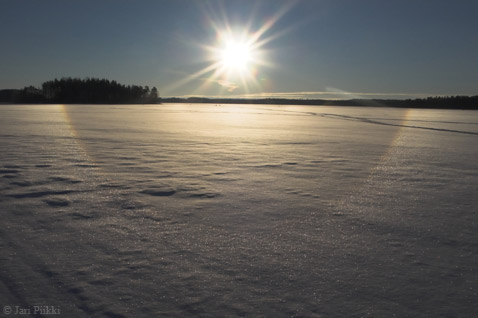Sometimes a surface halo can be more than a couple of colored crystals forming a vague half circle on the snow. Such was the case on 8 January 2006 in Juva, where Jari Piikki photographed the display shown above.
22° halo is the dominating feature, but closer look reveal also halos from pyramid crystals. In darker version of the same image 9° halo is visible and a short patch of 24° halo is seen on the right where the 22° halo meets the forest ( 1 ).
Earlier, an odd radius halo had been observed on snow surface in Germany, where Richard Löwenherz saw 24° halo accompanying the 22° halo on 10 December 1998 ( 1 ). On 3 December 1986 in Kuopio, Finland, Juhana Hakumäki observed 9° and 22° halos on frosty window. The 22° halo was reported to have double spectrum, an indication of the presence of 24° halo.
Crystal photos from surface halo displays are scarce and as far as I know none are available from the displays with odd radius halos. However, pyramid crystals have been sampled from snow surface. At South Pole in December 1998 Jarmo Moilanen decided to have a look at the snow surface composition under a microscope, and to his surprise saw pyramid crystals ( 1 - 2 ). Unfortunately sun was too high to see the possible odd radius halos.
Marko Riikonen

very beautiful!
ReplyDeleteThe most beautiful surface halo I've ever seen ...
ReplyDeleteWhat a beautiful photograph! And a really fantastic phenomena: offcourse I knew that halo's exists on a snow surface, but I didn't know that pyramidal crystals also are possible on a snow surface, so I've learned something new!
ReplyDeleteThis is the first photo I've seen of a 22 deg. ring on the ground that brings out the parabolic shape of the halo on the ground. The effect is usually lost when photographing. Very nice.
ReplyDeleteHmm, how much distortions created by lens are affecting here ? (usually a problem in wide angle lenses, especially near the edges / cornerr)
ReplyDeleteI don't think lens distortion plays any role here. This photo is taken with a standard wide angle lens, like 28mm, where the distortions of 22° halo are not noteworthy even though the Sun is not in the middle of the frame.
ReplyDeleteI do not know what lens Jari has used, but I guessed a 28mm wide angle and made an illustration of the celestial coordinate projection that roughly matches Jari's photo. There one can see that the distortions don't bend the 22° halo much. And furthermore, I think that Lauri ment the parabolic feeling that you get looking at the photo which is mainly due to the brightness distribution of the halo. Visually the parabolic feeling is much stronger and usually does not come through in a photo. But here Jari Piikki has managed to capture nature through a viewfinder very well, which is typical for his photos in general as well.
This one's another gem from Piikki! Possibly the best surface halo photograph that I have ever seen.
ReplyDeleteMust be the best.
ReplyDeleteYes, lens distortions are neglible here (I drew a circle around the sun and the halo fits perfectly). Might have something to do with the intensity profile of the halo. Or maybe it's just me.
ReplyDeleteAnyway the parabolic effect seems prominent here, just what it looks like visually. E.g. the surface halo photo in Tape's book appears just circular.
If diamond dust halos don't make good stereo photos, maybe surface halos will? Next time any of you observe one, give it a try. Just take one photo, then move half a meter to the side and take another one with the same composition.
The link to the German display should be to the article "24°-Halo auf Schneedecke oder im Reif?"
ReplyDeletehttps://www.meteoros.de/themen/halos/arbeit-des-akm/24-halo-auf-schneedecke-oder-im-reif
regards,
Marko Riikonen